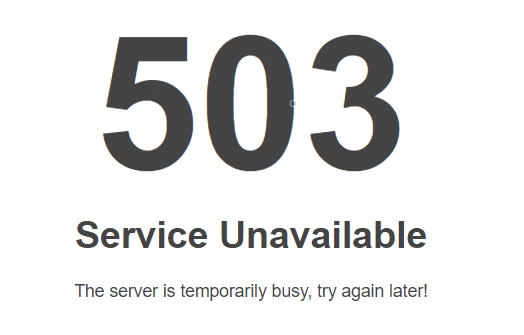List of content you will read in this article:
In this article, we will explain what is HTTP error 503, what causes the error to appear, and how to fix it. This is one of the most common and most irritating error messages you can get when trying to access a website.
Like many other HTTP-type errors, it is not easy to determine what exactly is causing the issue as someone who is just a general user; the error number is not helpful in determining the exact issue on its own.
There are a few ways that you can resolve this issue, however, but first, let us understand what 503 Errors mean.
What Does HTTP Error 503 Mean?

When you get the 503 Error, it means there is something stopping the browser from getting to the server of the target website. Usually, this indicates that the server is unable to process the request for information, but even with the symptom known, the cause isn't as obvious. The error therefore often comes with a slew of ways to fix the issue.
What Causes the 503 Error?
Much like with the 502 bad gateway error, finding the reason for the 503 Error is tricky. Typically, it has something to do with an item going wrong with the server that is supporting the website you want to access.
Among the many potential reasons, the most common reason for this error is that there has been a communication break between the website and the website's server, so it can't handle those information requests.
It is sometimes because of technical issues; sometimes it's because of scheduled server maintenance, and sometimes it's a problem with an inadequate hosting provider.
It could also show up if the server is online but still does not have the amount of capacity it needs to support the sheer number of information requests being given, which is something that happens when a low-traffic site is suddenly flooded with a lot of new users at once.
The traffic spike makes it difficult for people to access the site and gives the 503 Error quite easily.
How to Fix the 503 Error
The easiest way to fix the issue is to simply refresh the page to submit that request for information yet again. If you want a more potent option, you can restart the computer or the router itself to see if it helps.
If you do this and the error message gives you verbiage like "service unavailable - DNS failure," there is a chance that there could be a faulty element in the configuration of the DNS through the hardware you have running.
That can typically be fixed just by restarting the computer again. When it comes to an issue with a certain DNS server, it could be fixed by picking another one to use.
If the 503 Error is an issue on the side of the server, then there is nothing that a simple site visitor can do to resolve the issue.
The host will have to fix it from their end. If that's you and you are getting 503 Error reports often, then the administrator of the site will have to find and troubleshoot the issue to remedy the problem.
To avoid these issues for customers as much as possible, if there is maintenance that needs to be done on the site, it is best to do it at a quieter time with less traffic so the users aren't constantly shown this message.
If it is indeed caused by a spike in traffic, then it may be a good idea for you to increase the available resources for the webserver in order to accommodate the new influx of users. This is especially true if you foresee your site consistently getting more traffic going forward instead of just one quick spike, such as when you run promotions and get a flock of new hits.
If you are getting the error because of a DoS, or denial of service attack, you should contact the hosting provider.
By doing so, you can check the things you can do to stop it from happening again. In the case of such an attack, you might also want to consider increasing the level of security of your server and site or put in patches against the areas a hacker may try to exploit when attacking your site.
A lot of hosting providers already have protection against DDoS attacks in place, and this can limit the number of people able to get to the site at any given time.
If you're not running an anti-virus program, it would be a good idea to open one up just to ensure any malware doesn't cause the error.
It could also be a general configuration issue. For instance, if your code is set up only to accommodate a certain amount of users, the error will show up even if the capacity for it is larger.
If it is a maintenance issue, getting a more detailed error message to publish can help you determine where things went wrong.
These error messages can explain the issue more in-depth by explaining the work that is being done on the website. It will also usually give you a roundabout estimate of when you can expect the maintenance to be complete on the site.
Finally, if the error is because of a programming mishap, you'll need to investigate it further to figure out how to narrow down the exact issue and then take the appropriate steps to fix it. If all else fails, contact the provider of the site.
Conclusion
The HTTP error 503 is a frustrating problem that has a lot of sources but only a few ways to try and fix it, especially if you're experiencing it from the user's end instead of the business end.
Even so, it is not impossible to get around such an error, and in this article, we've discussed a few ways to tackle the HTTP error 503s. If the problem persists, contact the provider to get more in-depth and work out the issue.
